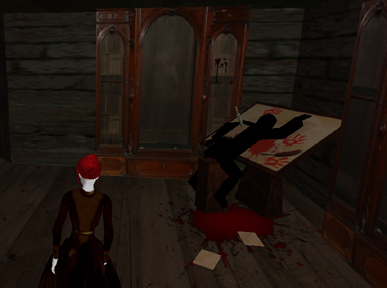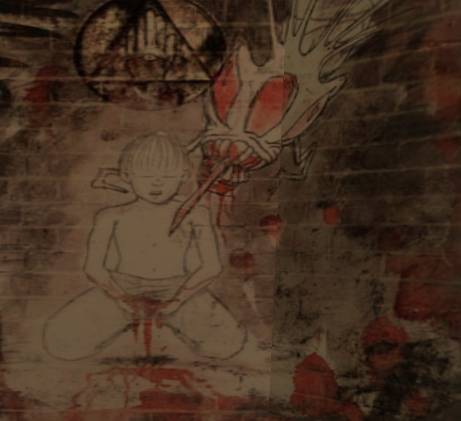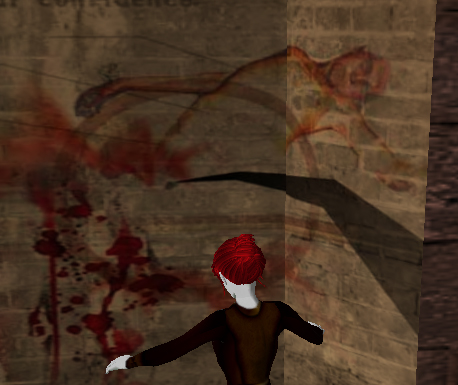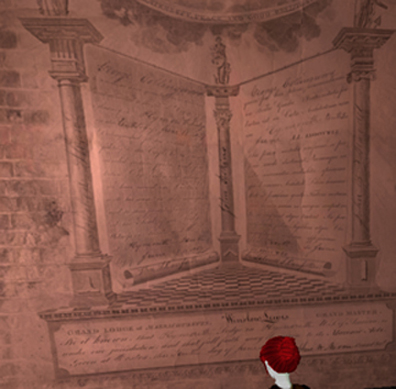Figure 1:

This photograph reveals the corpse of Alexander Loki, the body the orphans of New Babbage referred to as "The Sleeping Man." The location is in the attic of Loki's Absinthe. The scene is much as Prof. Nishi described. I assume this photograph was taken by Artemisia Paine, as Prof. Nishi is plainly visible in the foreground. Also visible here is a spectral image in the glass of the cabinet on the corpse's left, a face, which is not mentioned in the Nishi typescript until several days after her discovery of the dead man.
Figure 2:

Possibly the most horrific of these photographs is this one of graffiti on an interior wall of the Imperial. I have examined these images myself and can attest to their authenticity. Here we see a young boy on his knees, with some monstrous being crouched above him. The boy holds something bloody is his cupped hands. Was this image painted by one of the orphans? Does it depict one of their number making an offering? Note also the symbol that appears above the boy's head: a circle enclosing a triangle, which, in turn, surrounds an open palm bearing an eye. My own tests indicate that much of the reddish pigment, especially that to the right, is human blood.
Figure 3:
Detail of the symbol from Figure 2.
Figure 4:

This image shows writing on the same wall, located above and to the right of the image of the kneeling boy and the monstrous being. I believe this script was placed upon the masonry long before the more gruesome images. Most of it was obliterated by the later graffiti. The quote is from George Washington, and in full would read:
"Be courteous to all, but intimate with few, and let those few be well tried before you give them your confidence. True friendship is a plant of slow growth, and must undergo and withstand the shocks of adversity before it is entitled to the appellation."
I have placed in bold red those letters and words that may be easily discerned.
Figure 5:

Another grotesque and enigmatic image, which was located to the right (south) of the kneeling boy and the above quotation. The body of a man lies half in view, and half in, half out of a circle. The style here is markedly more realistic than that of the kneeling boy and the creature, and so I conclude it might have been painted by another hand. From Prof. Nishi's notes, I have learned that it put her in mind of the Ouroboros, if one sees the man's right hand as the head of the serpent swallowing its tail. More blood stains are present, as well. The man appears to be sleeping or deceased. Note, also, the peculiar dark shaft which enters or exits the circle's center. In her writings, the Prof. seemed to associate this aspect of the image with the Greek omphalos, or "world navel," and believed it a "symbolic interpretation of Alexander Loki's Porta Terrarum Device." Additionally, she writes: "Omphalos stones were said to allow direct communication with the gods."
Figure 6:

A mural inside the Imperial, located west of the Figs. 2-5, of obvious Masonic origin. I will return to this image in a later appendix.
Figure 7:
In Prof. Nishi's estimation, this was the most important image of these seven. Her notes indicate that it was taken on the nearby island of Sunrise, near Nemo Beach, in a lab that had belonged to Mr. Alexander Loki. Here we see his schematics for the "Porta Terrarum Device," and a list of its three components. The significance of the two images tacked upon the drafting table to the left of the schematic remain a mystery to me. The letter, visible below them, I will treat in Appendix B.

No comments:
Post a Comment